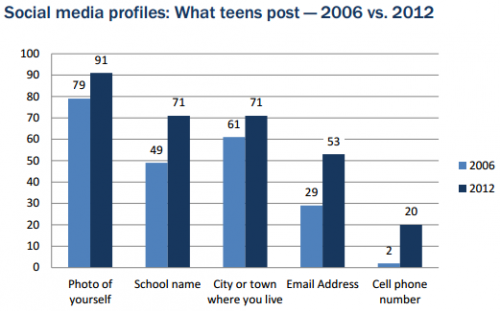Pew Research Center’s May 2013 report on Teens, Social Media & Privacy was the result of a nationally representative phone survey of 802 parents and their 802 teens aged 12-17 in the US. It combines data with insights and quotes from 24 focus groups (156 students in total) that took place from February 2013. The social media sites mentioned by the teens cover Facebook, LinkedIn, Google Plus, Twitter, Instagram and Tumblr.
Out of the 802 teens surveyed, 80% of teens are use social networking sites, a number that has remained pretty consistent over the past few years.
The full report is defintely worth a read, but it’s a bit of a beast at 107 pages, so we’ve handpicked the key findings that we think stand out most:
1. Teens are sharing more information than ever on Facebook
Social networking sites are designed to promote sharing of content and amplification of networks, yet few teens are comfortable with sharing their personal details publicly. However, it is apparent that teens are still sharing personal information among their networks of friends more than ever compared with 2006. The largest increases in information shared (and most surprisingly given the recent movements to better educate teens about sharing online) have been with posting their email address (53% up from 29%) and mobile phone number (20% up from 2%).
Most of the teens interviewed have a presence on several social media platforms, with Facebook, unsurprisingly being the dominant one. Of this, the survey reported:
- 92% post their real name to Facebook*
- 84% post their interests, such as movies, music, or books they like
- 82% post their birth date
- 62% post their relationship status
- 24% post videos of themselves
*Given that Facebook requires a first name and surname, this isn’t surprising.
2. Yet they value their privacy
Teen users are savvy when it comes to their private / public settings – they understand how it operates and the majority choose only to share their content with their friends. This confidence increases with age and approximately 41% of Facebook users aged 12-13 report that it’s ‘not difficult at all’ to manage their privacy controls, compared to 61% of users aged 14-17.
As a result:
- 60% of Facebook teens only share content with approved friends
- 25% have partially private settings, allowing friends of friends to see what they post
- 14% of this audience have an entirely public profile
In addition, there is a trend for girls (70%) over boys (50%) to have a private profile that only allows friends to see their content.
3. Teens care greatly about their online identity
Teens spend time trimming and shaping their social media profiles and aren’t afraid to delete posts, remove themselves from tagged photos or even delete entire accounts to keep their online reputation safe.
For many teens participating in the focus groups, their digital activity, especially on Facebook was viewed as an extension of their lives offline, with similar social interactions and weightings on factors such as popularity (determined by the number of ‘likes’ their posts were getting, as well as number of friends). Teen Facebook users were even manipulating their profiles to show it in the best possible light with the number of ‘Likes’ being the most important influence. So much so that photos considered ‘unpopular’ or with too few likes were being removed.
The report found that:
- 59% have deleted or edited something that they posted in the past
- 53% have deleted comments from others on their profile or account
- 45% have removed their name from photos that have been tagged to identify them
- 31% have deleted or deactivated an entire profile or account
- 19% have posted updates, comments, photos, or videos that they later regretted sharing
It’s also perhaps no surprise that that survey found that 58% share inside jokes and coded messages that only certain sets of their friends will understand. From our experience of moderating online social media sites aimed at children, this is something we come across on a daily basis.
4. Teens’ online social networks mirror their offline networks
The study showed that Facebook, more so than any other social network discussed, somewhat mirrored their offline networks:
- 98% of Facebook-using teens are friends with people they know from school
- 91% of teen Facebook users are friends with members of their extended family
- 89% are connected to friends who do not attend the same school
- 76% are Facebook friends with brothers and sisters
- 70% are Facebook friends with their parents
- 33% are Facebook friends with other people they have not met in person
- 30% have teachers or coaches as friends in their network
- 30% have celebrities, musicians or athletes in their network
Think of the implications this has on the number of people who can view a teen’s profile, especially if their privacy is set to ‘friends of friends’.
5. And how does the behavior of a teen with a larger network (over 600 Facebook friends) differ?
Similarly to real life, there are natural consequences that come with having a wider network. For example:
- They share a wider range of information
- More active management of their online profile
- They visit social networking sites more often – 65% of teen with over 600 Facebook friends logon to their online profiles several times a day, compared with 27% of teens with 150 or fewer Facebook friends
- Teens with more than 600 Facebook friends are three times more likely to have a Twitter account and six times more likely to use Instagram
5. Facebook is slowly falling out of favour
Amongst the focus groups, there was a lot of dissatisfaction with Facebook.
And for several reasons:
- There are too many adults on Facebook
- Friends are ‘oversharing’ – especially content that they think is boring or inane
- There is too much ‘Facebook drama’ which can be draining
- Maintaining their profile and reputation on Facebook takes more work and can be stressful
- There are fewer social expectations and constraints on other sites such as Instagram or Twitter
Does this mean an exodus of teen users? Not yet. Facebook appears to be where the majority of their digital socialising takes place and teens worry that they’ll miss out if they leave or neglect Facebook. This doesn’t stop them from taking brief escapes from Facebook and spending time on other sites such as Twitter and Instagram, before returning to Facebook.
6. Twitter use is on the up
Facebook is still the dominant social networking platform for teens, however Twitter use is growing significantly; 25% of teens have used Twitter in some way, which is up from 16% in 2011.
And unlike Facebook users where 60% only share their profile with their friends, the majority of teens (64%) are happy to share their tweets publicly. 24% keep their tweets hidden and only visible to followersthey choose to accept, and 12% aren’t sure whether their tweets are public or not.
The expanse of their social networks vary greatly also – teen Twitter users don’t tend to have as large a network as teen Facebook users – the typical (median) teen Twitter user has 79 followers compared to 300 on Facebook.
What does this mean for brands?
With social networking sites, in particular Facebook, acting as an extension of most teens offline life and a visible popularity indicator, managing their profile to show themselves off in the best possible light is top priority. ‘Likes’ and the types of comments they receive are critical, and the majority won’t think twice about removing content, or choosing not to engage with content that they feel may lower their online status.
Here are some areas that you should consider when targeting teens on social networks:
- Create content that gives users something that others brand don’t that actively contributes to a teen’s reputation. Whether that’s through humour, status, value or exclusivity.
- The main way to increase exposure of your brand is by creating content that these teens want to share. Are you doing that?
- Teens value their privacy. Whilst the majority are comfortable with managing their privacy settings on Facebook they will feel betrayed by any brand who unbeknownst to them shares or uses their information without them knowing. In the past, brands with Facebook apps have been particularly at fault for sharing their users’ content.
- If you’re asking them to participate in competitions, think from a teen’s point of view – are the conditions of entry a barrier? Questions they will be asking are: Will my friends know I’ve entered? Do I even have control of that?
- Teens with a prolific network on their Facebook page (over 600 friends) are also highly likely to be on Twitter or Instagram. This is also the audience who will share and be more active on social networks. Does your digital strategy combine these other social media platforms too in a way that they can all work together?
- Social media platforms, other than Facebook, are increasing in use by teens. Make it a priority to understand where your particular teen audience are hanging out and what they’re talking about. There are a lot of brands ‘winning’ on sites such as Tumblr, Twitter, Google+ and Instagram.




